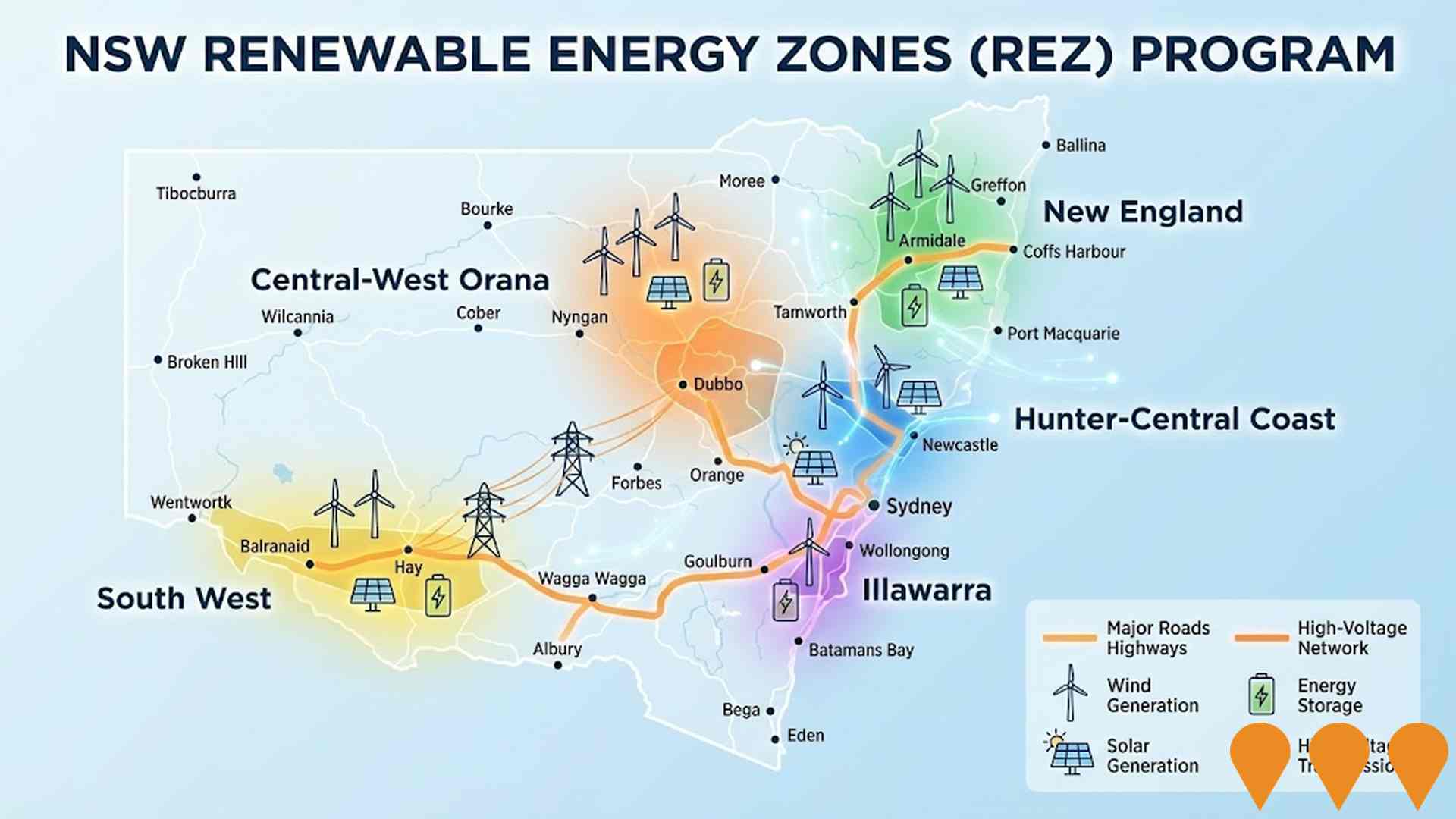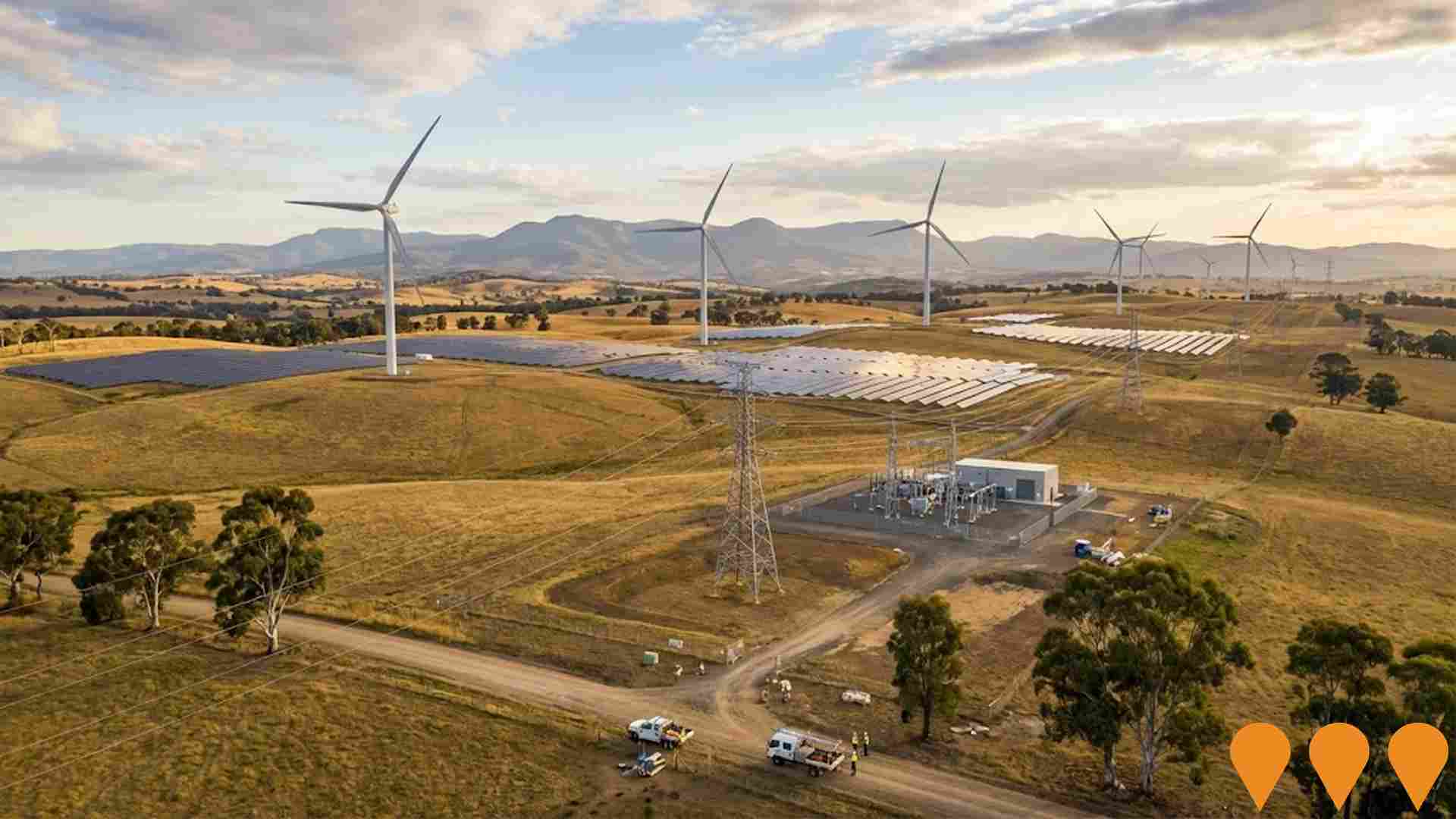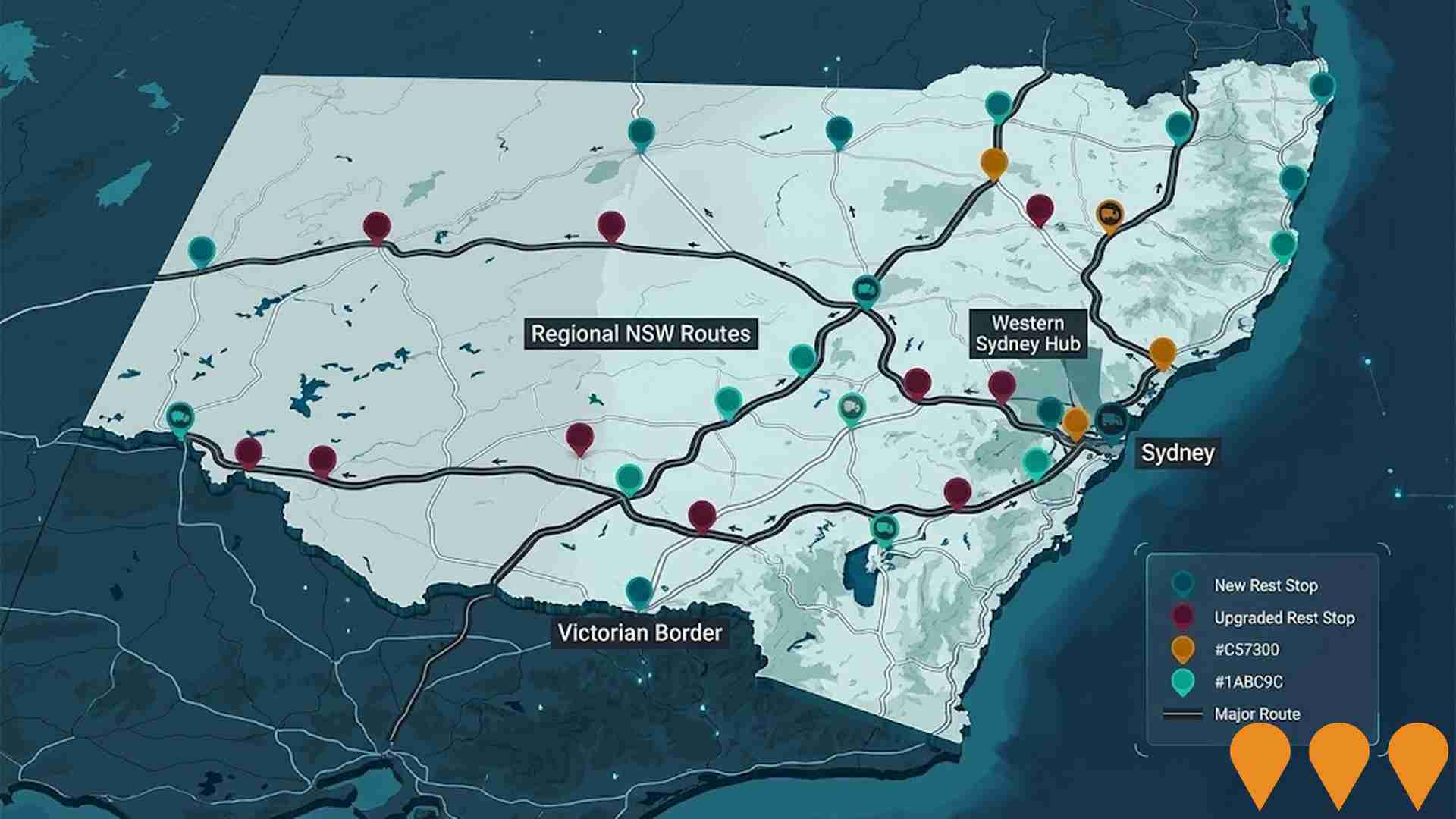Chart Color Schemes
est. as @ -- *
ABS ERP | -- people | --
2021 Census | -- people
Sales Activity
Curious about local property values? Filter the chart to assess the volume and appreciation (including resales) trends and regional comparisons, or scroll to the map below view this information at an individual property level.
Find a Recent Sale
Sales Detail
Population
West Wimmera has shown very soft population growth performance across periods assessed by AreaSearch
West Wimmera's population is approximately 2,701 as of August 2025. This figure represents a decrease of 65 people since the 2021 Census, which recorded a population of 2,766. The change is inferred from the estimated resident population of 2,680 in June 2024 and an additional 4 validated new addresses since the Census date. This results in a population density ratio of 0.50 persons per square kilometer. West Wimmera's population decline of -2.3% since the census is similar to the SA3 area's decline of -0.6%. Population growth was primarily driven by overseas migration during recent periods.
AreaSearch uses ABS/Geoscience Australia projections for each SA2 area, released in 2024 with a base year of 2022. For areas not covered, AreaSearch utilises VIC State Government's Regional/LGA projections from 2023, adjusted using weighted aggregation methods to SA2 levels. Growth rates by age group are applied across all areas for years 2032 to 2041. According to these projections, West Wimmera's population is expected to shrink by 856 persons by 2041.
Frequently Asked Questions - Population
Development
The level of residential development activity in West Wimmera is very low in comparison to the average area assessed nationally by AreaSearch
West Wimmera had minimal construction activity from 2013 to 2017 with only two new dwellings approved annually on average. This resulted in a total of thirteen dwellings over the five-year period. The low development levels are characteristic of rural areas like West Wimmera, where housing needs often dictate development rather than broad market demand.
It is important to note that yearly growth figures and relativities can vary significantly due to the small number of approvals. Compared to other regions such as Rest of Vic., West Wimmera has much lower development activity, which also falls below national averages. Recent developments in the area have been exclusively detached houses, reflecting its rural character where larger properties are typical. The estimated population per dwelling approval is 718 people, indicating a quiet and low-activity development environment.
With stable or declining population projections, West Wimmera may experience reduced housing pressure, potentially presenting opportunities for buyers.
Frequently Asked Questions - Development
Infrastructure
West Wimmera has emerging levels of nearby infrastructure activity, ranking in the 26thth percentile nationally
No changes can significantly impact a region's performance like modifications to local infrastructure, major projects, and planning initiatives. A total of zero projects have been identified by AreaSearch as potentially affecting this area. Notable projects include Lower Limestone Coast Water Allocation Plan, Limestone Coast Energy Park, Melbourne To Adelaide Freight Rail Improvements, and Victorian Renewable Energy Zones, with the following list outlining those most likely to be relevant.
Professional plan users can use the search below to filter and access additional projects.
INFRASTRUCTURE SEARCH
 Denotes AI-based impression for illustrative purposes only, not to be taken as definitive under any circumstances. Please follow links and conduct other investigations from the project's source for actual imagery. Developers and project owners wishing us to use original imagery please Contact Us and we will do so.
Denotes AI-based impression for illustrative purposes only, not to be taken as definitive under any circumstances. Please follow links and conduct other investigations from the project's source for actual imagery. Developers and project owners wishing us to use original imagery please Contact Us and we will do so.
Frequently Asked Questions - Infrastructure
NSW Renewable Energy Zones (REZ) Program
NSW is delivering five Renewable Energy Zones (Central-West Orana, New England, South West, Hunter-Central Coast and Illawarra) to coordinate new wind and solar generation, storage and high-voltage transmission. The program is led by EnergyCo NSW under the Electricity Infrastructure Roadmap. Construction of the first REZ (Central-West Orana) transmission project commenced in June 2025, with staged energisation from 2028. Across the program, NSW targets at least 12 GW of new renewable generation and 2 GW of long-duration storage by 2030.

Victorian Renewable Energy Zones
VicGrid, a Victorian Government agency, is coordinating the planning and staged declaration of six proposed onshore Renewable Energy Zones (plus a Gippsland shoreline zone to support offshore wind). The 2025 Victorian Transmission Plan identifies the indicative REZ locations, access limits and the transmission works needed to connect new wind, solar and storage while minimising impacts on communities, Traditional Owners, agriculture and the environment. Each REZ will proceed through a statutory declaration and consultation process before competitive allocation of grid access to projects.

EnergyConnect
Australia's largest energy transmission project. A new ~900km interconnector linking the NSW, SA and VIC grids. NSW-West (Buronga to SA border and Red Cliffs spur) was energised in 2024-2025, connecting the three states via the expanded Buronga substation. NSW-East (Buronga-Dinawan-Wagga Wagga) is under active construction with substation upgrades at Wagga Wagga completed in June 2025 and works well advanced at Dinawan and Buronga. Full 800MW transfer capability is targeted after completion of the eastern section and inter-network testing, expected by late 2027.

Regional Housing Fund (Victoria)
A $1 billion Homes Victoria program delivering around 1,300 new social and affordable homes across at least 30 regional and rural LGAs, using a mix of new builds, purchases in new developments, renewals and refurbishments. Delivery commenced in late 2023 with early completions recorded; overall fund completion is targeted for 2028.

NSW Heavy Vehicle Rest Stops Program (TfNSW)
Statewide Transport for NSW program to increase and upgrade heavy vehicle rest stopping across NSW. Works include minor upgrades under the $11.9m Heavy Vehicle Rest Stop Minor Works Program (e.g. new green reflector sites and amenity/signage improvements), early works on new and upgraded formal rest areas in regional NSW, and planning and site confirmation for a major new dedicated rest area in Western Sydney. The program aims to reduce fatigue, improve safety and productivity on key freight routes, and respond to industry feedback collected since 2022.

Lower Limestone Coast Water Allocation Plan
A water allocation plan setting rules for groundwater management in the Lower Limestone Coast, ensuring long-term sustainability and security of the water resource for environmental, social, cultural, and economic needs.

Limestone Coast Energy Park
The Limestone Coast Energy Park includes two co-located batteries totaling 500 MW / 1,500 MWh in South Australia's Limestone Coast area.

Melbourne To Adelaide Freight Rail Improvements
Enhancing the Melbourne to Adelaide freight rail to allow double-stacked containers by addressing 1,020 clearance obstructions, potentially reducing costs by 6% and increasing capacity by 48%.

Employment
Employment performance in West Wimmera has been broadly consistent with national averages
West Wimmera has a balanced workforce with both white and blue collar jobs, diverse industry representation, and an unemployment rate of 2.4% as of June 2025. The area employs 1,406 residents with an unemployment rate 1.4% lower than Rest of Vic.'s 3.8%, and a workforce participation rate similar to the regional average of 57.4%.
Key industries include agriculture, forestry & fishing, health care & social assistance, and education & training. Agriculture, forestry & fishing is particularly strong with an employment share 6.4 times the regional level, while construction shows lower representation at 4.1% compared to the regional average of 10.4%. Many residents commute elsewhere for work based on Census data. Between June 2024 and June 2025, labour force decreased by 4.3%, employment declined by 4.0%, leading to a 0.3 percentage point drop in unemployment rate.
Rest of Vic., however, saw an employment decline of 0.9%, labour force decline of 0.4%, with unemployment rising 0.4 percentage points. Jobs and Skills Australia's national employment forecasts from May 2025 project national employment growth of 6.6% over five years and 13.7% over ten years, but industry-specific projections suggest West Wimmera's growth could be approximately 4.7% over five years and 11.0% over ten years.
Frequently Asked Questions - Employment
Income
Income figures position the area below 75% of locations analysed nationally by AreaSearch
West Wimmera had a median taxpayer income of $46,752 and an average of $58,832 in financial year 2022, according to postcode level ATO data aggregated by AreaSearch. This was lower than the national average, with Rest of Vic.'s median income being $48,741 and average income being $60,693. Based on Wage Price Index growth of 12.16% since financial year 2022, estimated incomes as of September 2025 would be approximately $52,437 (median) and $65,986 (average). According to Census 2021 income data, personal income ranked at the 28th percentile ($698 weekly), while household income was at the 12th percentile. Income analysis showed that the $1,500 - $2,999 bracket dominated with 25.7% of residents (694 people). Housing costs were modest, with 94.4% of income retained. However, total disposable income ranked at just the 23rd percentile nationally, and the area's SEIFA income ranking placed it in the 4th decile.
Frequently Asked Questions - Income
Housing
West Wimmera is characterized by a predominantly suburban housing profile, with above-average rates of outright home ownership
In West Wimmera, as per the latest Census evaluation, 96.4% of dwellings were houses with 3.7% being other types such as semi-detached homes, apartments, and 'other' dwellings. This is compared to Non-Metro Vic.'s 93.0% houses and 6.9% other dwellings. Home ownership in West Wimmera stood at 60.1%, with mortgaged properties at 23.7% and rented ones at 16.2%. The median monthly mortgage repayment was $758, lower than Non-Metro Vic.'s average of $1,043. The median weekly rent in West Wimmera was recorded at $150, compared to Non-Metro Vic.'s $215. Nationally, West Wimmera's mortgage repayments were significantly lower than the Australian average of $1,863, with rents substantially below the national figure of $375.
Frequently Asked Questions - Housing
Household Composition
West Wimmera features high concentrations of lone person households, with a lower-than-average median household size
Family households account for 60.8 percent of all households, including 20.7 percent couples with children, 32.9 percent couples without children, and 6.7 percent single parent families. Non-family households constitute the remaining 39.2 percent, with lone person households making up 36.4 percent and group households comprising 2.8 percent of the total. The median household size is 2.1 people, which is smaller than the Rest of Vic. average of 2.2.
Frequently Asked Questions - Households
Local Schools & Education
Educational outcomes in West Wimmera fall within the lower quartile nationally, indicating opportunities for improvement in qualification attainment
The area faces educational challenges, with university qualification rates at 16.3%, substantially below the VIC average of 33.4%. This represents both a challenge and an opportunity for targeted educational initiatives. Bachelor degrees lead at 11.8%, followed by graduate diplomas (2.4%) and postgraduate qualifications (2.1%). Trade and technical skills feature prominently, with 38.0% of residents aged 15+ holding vocational credentials – advanced diplomas (11.1%) and certificates (26.9%).
Educational participation is notably high, with 25.6% of residents currently enrolled in formal education. This includes 11.4% in primary education, 6.5% in secondary education, and 1.5% pursuing tertiary education. West Wimmera's 4 schools have combined enrollment reaching 281 students as of the latest data. The area demonstrates typical Australian school conditions (ICSEA: 980) with balanced educational opportunities. The educational mix includes 2 primary, 2 K-12 schools. School places per 100 residents (10.4) fall below the regional average (13.8), with some students likely attending schools in adjacent areas.
Frequently Asked Questions - Education
Schools Detail
Nearby Services & Amenities
Transport
Transport servicing is very low compared to other areas nationally based on assessment of service frequency, route connectivity and accessibility
West Wimmera has four active public transport stops operating, all of which are bus stops. These stops are served by one route in total, offering ten weekly passenger trips combined. Transport accessibility is limited, with residents located an average of 3367 meters from the nearest stop.
On average, there is one trip per day across all routes, equating to approximately two weekly trips per individual stop.
Frequently Asked Questions - Transport
Transport Stops Detail
Health
Health performance in West Wimmera is well below average with prevalence of common health conditions notable across both younger and older age cohorts
West Wimmera faces significant health challenges, with common conditions prevalent across both younger and older age groups. Private health cover stands at approximately 49% (1,326 people), lower than the national average of 55.3%.
The most frequent medical issues are arthritis (12.4%) and mental health concerns (7.7%), while 64.4% report no medical ailments, compared to 61.2% in Rest of Vic. The area has a higher proportion of seniors aged 65 and over at 29.5% (796 people), compared to the state average of 25.2%. Health outcomes among seniors are above average, outperforming general population metrics.
Frequently Asked Questions - Health
Cultural Diversity
The latest Census data sees West Wimmera placing among the least culturally diverse areas in the country when compared across a range of language and cultural background related metrics
West Wimmera had a cultural diversity index below the average, with 87.6% of its population being citizens, 92.1% born in Australia, and 97.2% speaking English only at home. Christianity was the predominant religion in West Wimmera, accounting for 57.7% of the population, compared to 51.6% across Rest of Vic.. The top three ancestry groups were English (32.3%), Australian (32.2%), and Irish (9.6%).
Notably, German (6.9%) and Scottish (9.4%) were overrepresented in West Wimmera compared to regional averages of 6.6% and 9.0%, respectively. Samoan representation was also higher at 0.2%.
Frequently Asked Questions - Diversity
Age
West Wimmera ranks among the oldest 10% of areas nationwide
West Wimmera's median age is 51 years, significantly higher than Victoria's average of 43 and Australia's median of 38. The 65-74 cohort is notably over-represented at 16.4%, compared to the Rest of Vic.'s average of 9.4%. Conversely, the 15-24 age group is under-represented at 7.6%. Post-Census data shows the 25-34 age group grew from 8.7% in 2021 to 10.0%, while the 35-44 cohort increased from 9.4% to 10.5%. Meanwhile, the 55-64 cohort declined from 17.9% to 15.8%, and the 45-54 group dropped from 12.9% to 10.8%. By 2041, West Wimmera's age composition is expected to shift notably. The 85+ group will grow by -16 people (-18%), reaching 101 from 119. Population declines are projected for the 85+ and 0-4 cohorts.

